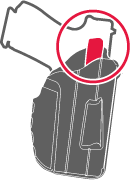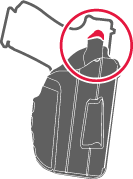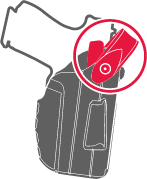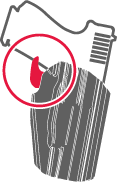Security Mechanisms Explained
 The ALS is often called a thumb release or lever, and it sits to the inside of the body of the holster against the user. The system uses an internal locking mechanism that secures the gun in all directions simply upon re-holstering. To release the firearm from a positive lock, the operator must press the lever back. Once the device is released, the firearm can be drawn straight out of the holster with no twisting or other motion required. Additionally, holsters with this ergonomic design are completely operable with the thumb, and the straight up draw makes them very instinctive to use. On Duty Rated Holsters, the ALS provide Level 1 retention.
The ALS is often called a thumb release or lever, and it sits to the inside of the body of the holster against the user. The system uses an internal locking mechanism that secures the gun in all directions simply upon re-holstering. To release the firearm from a positive lock, the operator must press the lever back. Once the device is released, the firearm can be drawn straight out of the holster with no twisting or other motion required. Additionally, holsters with this ergonomic design are completely operable with the thumb, and the straight up draw makes them very instinctive to use. On Duty Rated Holsters, the ALS provide Level 1 retention.
 The ALS® guard provides additional security for holsters featuring the ALS® security mechanism. This device covers the ALS lever to prevent any accidental or unauthorized use. It can be retrofitted onto existing ALS holsters without the SLS System. The ALS Guard can be added to the Duty Rated Level 1 Retention Holsters to achieve Level II Retention.
The ALS® guard provides additional security for holsters featuring the ALS® security mechanism. This device covers the ALS lever to prevent any accidental or unauthorized use. It can be retrofitted onto existing ALS holsters without the SLS System. The ALS Guard can be added to the Duty Rated Level 1 Retention Holsters to achieve Level II Retention.
 The ALS/SLS combination provides an extra measure of security. Safariland’s patented ALS locks the firearm into place immediately upon holstering, while the SLS rotating hood and tension device ensure added security. On Duty Rated Holsters, the ALS/SLS combination provides Level 3 retention.
The ALS/SLS combination provides an extra measure of security. Safariland’s patented ALS locks the firearm into place immediately upon holstering, while the SLS rotating hood and tension device ensure added security. On Duty Rated Holsters, the ALS/SLS combination provides Level 3 retention.
 A flap covers the entire back of the handgun, and typically has a clasp which needs to be undone to lift the flap. The flap protects the handgun from the elements and are commonly found on military holsters.
A flap covers the entire back of the handgun, and typically has a clasp which needs to be undone to lift the flap. The flap protects the handgun from the elements and are commonly found on military holsters.
 The GLS is a unique security mechanism that requires the middle finger to release the firearm. With a proper shooting grip, the middle finger sits directly on the GLS lever. During the draw, the lever is depressed allowing for a smooth and easy straight up draw out of the holster. GLS holster models offer a low profile and compact design, perfect for concealability.
The GLS is a unique security mechanism that requires the middle finger to release the firearm. With a proper shooting grip, the middle finger sits directly on the GLS lever. During the draw, the lever is depressed allowing for a smooth and easy straight up draw out of the holster. GLS holster models offer a low profile and compact design, perfect for concealability.
 The Hood Guard provides an additional barrier for the SLS security mechanism by shielding access from the front of the holster and preventing intrusion from seatbelts and other foreign obstacles.
The Hood Guard provides an additional barrier for the SLS security mechanism by shielding access from the front of the holster and preventing intrusion from seatbelts and other foreign obstacles.
 The combination of the Hood Guard and Sentry Guard provides added protection to the SLS security mechanism. On Duty Rated Holsters the Sentry Guard increases the retention level by one.
The combination of the Hood Guard and Sentry Guard provides added protection to the SLS security mechanism. On Duty Rated Holsters the Sentry Guard increases the retention level by one.
 The PRD™ is an internal security mechanism that grips onto both sides of the trigger guard when the gun is fully seated in the holster. Made of a durable, high-tech polymer, it offers enhanced security and allows the user to feel when the handgun is fully seated in the holster.
The PRD™ is an internal security mechanism that grips onto both sides of the trigger guard when the gun is fully seated in the holster. Made of a durable, high-tech polymer, it offers enhanced security and allows the user to feel when the handgun is fully seated in the holster.
 The Sentry Guard provides an additional level of protection to the SLS security mechanism. On Duty Rated Holsters, the addition of the Sentry Guard increases the level of retention by one.
The Sentry Guard provides an additional level of protection to the SLS security mechanism. On Duty Rated Holsters, the addition of the Sentry Guard increases the level of retention by one.
 The SLS utilizes a rotating hood security mechanism, which provides greater protection against attempted firearm takeaways. To unlock the SLS security mechanism, the user first pushes the hood down, then rotates the hood forward to the unlocked position, which allows an opening to draw the firearm from the holster. On Duty Rated Holsters, the SLS provides Level II Retention.
The SLS utilizes a rotating hood security mechanism, which provides greater protection against attempted firearm takeaways. To unlock the SLS security mechanism, the user first pushes the hood down, then rotates the hood forward to the unlocked position, which allows an opening to draw the firearm from the holster. On Duty Rated Holsters, the SLS provides Level II Retention.
 The traditional thumb break or thumb snap, first designed by John Bianchi in 1960, features a strap that wraps around the hammer area of the handgun front to back securing the holstered firearm. The back part is typically steel reinforced, allowing for the thumb to push back towards the body to release the snap upon the draw.
The traditional thumb break or thumb snap, first designed by John Bianchi in 1960, features a strap that wraps around the hammer area of the handgun front to back securing the holstered firearm. The back part is typically steel reinforced, allowing for the thumb to push back towards the body to release the snap upon the draw.
 When the holster is molded closely around the trigger guard, it creates a tight friction fit. Optional adjustment screws may allow you to set the tension level.
When the holster is molded closely around the trigger guard, it creates a tight friction fit. Optional adjustment screws may allow you to set the tension level.





